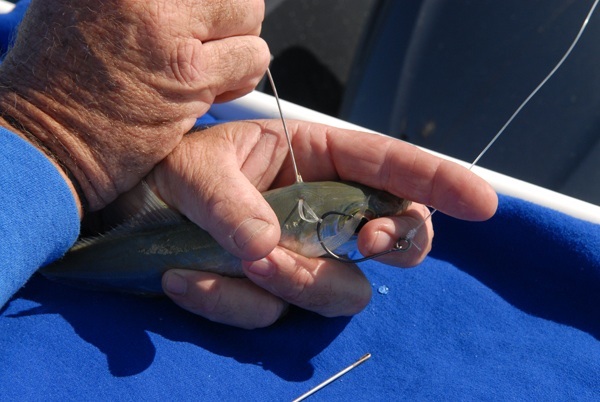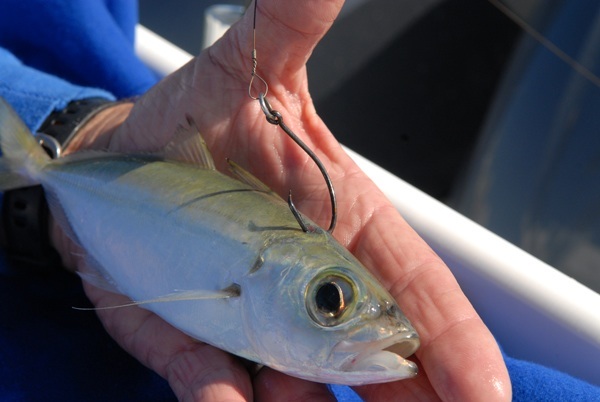There’s more than one way to rig a live bait…here are a few of the best! Fishing with live bait is an extremely effective technique for catching a wide range of gamefish, and Florida’s own George Mitchell is an expert on how to rig and fish ‘em. Mitchell, a 40-year veteran charter captain, guide, tournament fishermen and Yamaha Pro Angler, has been sharing his knowledge through Yamaha’s Saltwater School for many years. He also has an impressive number of wins and top ten finishes in the Southern Kingfish Association’s Professional Kingfish Tour. In this two-part series, Mitchell will demonstrate seven of the rigs he uses for kite, trolling and drift fishing for sailfish, kings and tuna. He will also cover deep drifting for bottom species and with downriggers.

“To fish live bait effectively, your boat has to have a live well and pump system capable of supporting them,” said Mitchell.
Mitchell’s 36-foot Yellowfin® powered by triple Yamaha F300s, Snake Dancer, has two large live wells fed by three 2000 GPH bilge pumps housed in a sea chest in the bilge. A network of valves and hoses allows each well to be fed just the right flow to accommodate goggle eyes, greenies, hardtails, mullet, bluefish and rainbow runners. The baits Mitchell uses are dictated by the location he fishes and the gamefish he targets. His boat is set up for charter and tournament fishing, and frequently carries many more baits than most anglers need, but his set up does demonstrate the importance of having a live well system that meets specific fishing needs. It’s never a good thing when the baits die halfway through a day of fishing.
Kite Bridle Rig
Mitchell is a big proponent of fishing with kites, and not just for sailfish. He flies kites for kingfish, blackfin and yellowfin tuna – almost any gamefish that will attack on the surface. This rig is specifically for sails and tuna, and will allow the baitfish to splash and swim invitingly on the surface while keeping the leader out of the water. The rig consists of a mini-barrel swivel, a long fluorocarbon leader and a circle hook. It’s important to have an “open eye” rigging needle and small plastic bands. Both are readily available at tackle shops.
Slip the plastic band into the needle eye and then over the hook as shown.
Insert the needle into the fish’s back, an inch or so behind the head, and pull the plastic band through, then detach it from the needle. Next, slip the hook point into the plastic band where the needle was and twist it a couple times.
Finish the rig by passing the hook point between the fish’s back and the band. This keeps the band from unraveling while allowing the hook to be completely exposed when a gamefish inhales the bait.
Drift Bridle Rig
The same basic technique can be used for drifting, slow trolling or even casting to a fish on the surface for a wide variety of non-toothy gamefish. It works whether the live bait is being fished on a flat line, with weight, or from a downrigger. It also maintains the advantage of having the circle hook completely exposed so it can easily wrap around the jaw structure of an attacking gamefish.
Start with the same needle, band and hook arrangement as above, but instead of inserting the needle in the back, pass it through the fish’s nostrils on the forward area of the head.
This rig is finished the same way as the first rig, the only difference is the position of the hook forward of the fish. This position allows the fish to swim naturally as it is pulled along by the boat.

Single Hook Wire Kite Rig
The Single Hook Wire Kite Rig comes into play when there are toothy fish, such as kingfish or wahoo, in the area. Your primary target with this rig could also be tuna or sailfish. The leader is the same as the two rigs above, but a trace of AFW Tooth Proof stainless steel wire (range from #5 through #7), about 12-inches long, is added with a mini-swivel on one end and a ringed circle hook on the other. Both are attached to the wire using a haywire twist.
Note that the hook is placed directly in the fish instead of using a bridle, and it is positioned in the same location as the other kite bait rig. Be careful not to plant the hook too deeply in the fish obstructing the gap between the hook point and shank. That makes it harder for the circle hook to wrap around the jaw structure of the attacking gamefish, and it can result in missed bites.
These three single-hook rigs cover a wide range of fishing applications, but are used primarily for gamefish such as sails, blackfin tuna, yellowfin tuna on the surface and bottom fish such as grouper, snapper and amberjack when fished deeper in the water column. They work well with baitfish such as goggle eyes, greenies, smaller mackerel, mullet and blue runners. The wire rig is a great way to avoid getting cut off by kingfish or wahoo while targeting other gamefish. The next installment will cover the tournament-proven rigs Captain Mitchell uses when specifically targeting kingfish during competition. Stay tuned.
